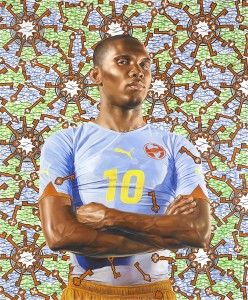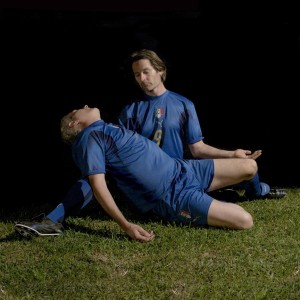LACMA fútbol exhibit fuses art and athletics
Over winter break, I came into the possession of a Los Angeles County Museum of Art pass.
Being the broke college student that I am, I’ve spent a lot of time in recent weeks trolling the LACMA website, looking for exhibits to attend. One show in particular caught my eye: “Fútbol: The Beautiful Game.”
I grew up playing soccer and I’ve always loved art, but I never thought of the two as being particularly connected. In fact, on a superficial level, sports and art are seemingly incredibly disparate. But after digging around a little bit — looking for similar sports-related exhibitions, or other areas of life where the two intersect — I came to realize that there is a good amount of crossover.

“Samuel Ento“, a painting by Kehinde Wiley, is on of the paintings on display at the exhibit. — Photo courtesy of LACMA
Looking toward the semester ahead, I plan to talk about art as a whole (film, television, art, music, literature), what art means to us, how it reflects society and why art itself is important.
These considerations could not be more applicable to the conversation at hand.
How are art and sports connected, if at all? What does this connection mean and what does it tell us about our perceptions of art and sports as a society? With that in mind, there are three main areas of interconnectedness that are particularly striking: sports as the subject of art, the athlete as the artist and sports as an extension of art itself.
“Fútbol: The Beautiful Game,” which opens Feb. 2, is a prime example of sports being the subject of art. It exemplifies this crossover between two areas of our culture. The exhibition, for example, features a portrait of former French soccer star Zinedine Zidane. The piece brings soccer into a long tradition of portraiture.
To Franklin Sirmans, Curator and Department Head of Contemporary Art, this depiction emits a sense of the “intense hero.” Heroics, of course, are seen in many aspects of life beyond sports, as are some of the greater themes of the show that Sirmans touched on: myth, fantasy, the icon, aspects of the body. More on this later.
Then, there’s the athlete as the artist: Todd Marinovich. Marinovich was essentially bred to be an all-star athlete by his father, Marv. He played as quarterback for USC from 1989 to 1990, but soon left for the NFL. Marinovich’s professional football career was short-lived due to his battle with drug addiction. He eventually turned to art.
Today, Marinovich paints, creating works both related and unrelated to football at his Todd Marinovich Art Gallery. Subject aside, many of Marinovich’s pieces are colorful, somewhat abstract and very expressive.
Sports can also be an extension of art. Consider dance: It’s highly athletic but is also very artistic. Where does one end and the other begin? What exactly is this blurring of lines? Then there’s ESPN’s “Body Issue.” Sports, athletes, they both become the subject of the photograph, but their bodies are also art in and of themselves, highly sculpted and well defined to be presented to the viewer.

Mimicking Michelangelo’s “Pieta”, this photograph turns the bodies of the players into art. — Photo courtesy of LACMA
Additionally, the “Body Issue” resonates with the extensive tradition of nudity in art history. Think: Michelangelo’s “David,” Manet’s “Olympia” and Picasso’s “Les Demoiselles d’Avignon (The Young Ladies of Avignon).” Here, Sirmans advises the viewer to be careful because once we start discussing the body, it takes on all these different meanings. But in this discussion, Sirmans brings up the connection between beauty in sports and in art.
“Within the game, there is this idea around beauty and around the human body, as it relates to that,” Sirmans said. “Different people find beauty in different places. I’m interested in how people relate to the exhibition. What is one’s idea of beauty as it relates to the human body?”
Beauty included, there’s a connection here between a number of different things beyond sports and art. As Sirmans touched on, sports carry stories of heroes, adversity, failure, loss and success. We’ve seen these themes throughout art for ages. Again, overlap.
Despite these thematic and artistic connections, we have created boundaries for what “sports” and “art” mean. We have separated the two, categorized them and made them their own very specific entities. If this is truly just a social construct, then why can’t we redefine these words to mean a number of different things?
Sirmans put it best: “For me [the exhibit is] less about it being sports-related as it is about it relating to an aspect of culture that is ripe for exploration on a more influential, educational and entertaining level.”
I’m not sure that I ever really believed that sports and art were so different. I don’t think I put much thought into it until writing this piece. Now I feel that sports and art are really both just aspects of culture. It’s time that we break the divide and consider them as such.
C. Molly Smith is a senior majoring in communication. Her column “Art Garfunkel” runs every other Friday.
